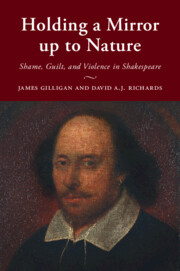Book contents
- Holding a Mirror up to Nature
- Holding a Mirror up to Nature
- Copyright page
- Dedication
- Epigraph
- Contents
- Introduction
- Chapter 1 Shame and Guilt in Personality and Culture
- Chapter 2 The Cycle of Violence in the History Plays
- Chapter 3 Fathers and Mothers
- Chapter 4 Make War, Not Love
- Chapter 5 The Motives of Malignity
- Chapter 6 Moral Nihilism and the Paralysis of Action:
- Chapter 7 Apocalyptic Violence
- Chapter 8 Transcending Morality, Preventing Violence
- Chapter 9 The Form and Pressure of Shakespeare’s Time and Ours
- Acknowledgments
- Bibliography
- Index
Introduction
Can We Learn from Shakespeare about the Causes and Prevention of Violence?
Published online by Cambridge University Press: 25 November 2021
- Holding a Mirror up to Nature
- Holding a Mirror up to Nature
- Copyright page
- Dedication
- Epigraph
- Contents
- Introduction
- Chapter 1 Shame and Guilt in Personality and Culture
- Chapter 2 The Cycle of Violence in the History Plays
- Chapter 3 Fathers and Mothers
- Chapter 4 Make War, Not Love
- Chapter 5 The Motives of Malignity
- Chapter 6 Moral Nihilism and the Paralysis of Action:
- Chapter 7 Apocalyptic Violence
- Chapter 8 Transcending Morality, Preventing Violence
- Chapter 9 The Form and Pressure of Shakespeare’s Time and Ours
- Acknowledgments
- Bibliography
- Index
Summary
Starting with the story of a man, a successful publisher, who like Othello kills his wife and then decides to kill himself, we find that Shakespeare’s plays are the richest source of insight into what motivates violence, toward others and also toward oneself, and what is needed to prevent violence. In contrast to Shakespeare, the mental health system has directed its attention almost exclusively to suicide, and relegated homicide to the criminal justice system. But that system asks only how evil are people who have committed murders and how much punishment they deserve– not what caused them to commit murder, and what we can do to prevent such behavior before it occurs. Criminology is of little help, because most violence is not criminal, and most crimes are not violent. More than experts in any of those fields, Shakespeare illuminates the thoughts, feelings, and social forces that drive people to kill others, themselves, or both.
- Type
- Chapter
- Information
- Holding a Mirror up to NatureShame, Guilt, and Violence in Shakespeare, pp. 1 - 17Publisher: Cambridge University PressPrint publication year: 2021

